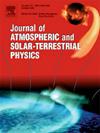Enhancing seismic activity classification in augmented soil gas radon time series data through computational intelligence techniques
IF 1.9
4区 地球科学
Q3 GEOCHEMISTRY & GEOPHYSICS
Journal of Atmospheric and Solar-Terrestrial Physics
Pub Date : 2025-06-07
DOI:10.1016/j.jastp.2025.106560
引用次数: 0
Abstract
The classification of seismic activities with anomalous radon time series (ARTS) is promising but hindered by unbalanced data. Rare events like earthquakes make standard classification methods less effective. For such types of problems supervised classification algorithms do not work effectively since they are designed to learn on balanced datasets. Specifically, different techniques viz. Synthetic Minority Over-sampling Technique (SMOTE), Density-Based Synthetic Minority Over-sampling Technique (DBSMOTE), and Adaptive Synthetic Sampling (ADASYN) have been used to address the class imbalance problem inherited within the original soil gas radon time series. Numerous machine and deep learning methods are considered to be the prominent classifiers, including logistic regression, support vector machines (SVM), XGBoost, long-short-term memory (LSTM), and convolutional neural networks (CNN). The investigation has been focused on optimizing the classification of imbalanced datasets through the selection of oversampling methods and learning algorithms. This study indicates that window size and overlapping parameters greatly affect model performance, particularly in discerning seismic events, with larger windows presenting challenges. SVM stands out as a relatively accurate classifier, consistently achieving competitive AUC values without overfitting. Data augmentation techniques show mixed effects, underscoring the need for careful selection based on dataset characteristics. This study suggests that SVM with oversampling methods offers an effective approach for seismic anomaly classification in earthquake prediction using soil radon gas time series data. The dataset for this study comprises soil radon and thoron gas concentration time series along with meteorological parameters spanning 14 months. Four seismic events were recorded during the data collection period. during the whole study period.
利用计算智能技术增强土壤气氡时间序列数据的地震活动分类
利用异常氡时间序列(ARTS)进行地震活动分类是一种很有前景的方法,但由于数据不平衡而受到阻碍。像地震这样的罕见事件使得标准的分类方法不那么有效。对于这种类型的问题,监督分类算法不能有效地工作,因为它们被设计为在平衡数据集上学习。具体来说,利用合成少数派过采样技术(SMOTE)、基于密度的合成少数派过采样技术(DBSMOTE)和自适应合成采样技术(ADASYN)来解决原始土壤气体氡时间序列中继承的类不平衡问题。许多机器和深度学习方法被认为是突出的分类器,包括逻辑回归、支持向量机(SVM)、XGBoost、长短期记忆(LSTM)和卷积神经网络(CNN)。研究的重点是通过选择过采样方法和学习算法来优化不平衡数据集的分类。该研究表明,窗口大小和重叠参数极大地影响了模型的性能,特别是在识别地震事件时,更大的窗口带来了挑战。SVM作为一种相对准确的分类器脱颖而出,在没有过拟合的情况下始终如一地获得具有竞争力的AUC值。数据增强技术显示混合效果,强调需要根据数据集特征进行仔细选择。该研究表明,基于过采样方法的支持向量机为土壤氡气时间序列地震预测中的地震异常分类提供了有效的方法。本研究的数据集包括14个月的土壤氡和钍气体浓度时间序列以及气象参数。在数据收集期间共记录了4次地震事件。在整个学习期间。
本文章由计算机程序翻译,如有差异,请以英文原文为准。
求助全文
约1分钟内获得全文
求助全文
来源期刊

Journal of Atmospheric and Solar-Terrestrial Physics
地学-地球化学与地球物理
CiteScore
4.10
自引率
5.30%
发文量
95
审稿时长
6 months
期刊介绍:
The Journal of Atmospheric and Solar-Terrestrial Physics (JASTP) is an international journal concerned with the inter-disciplinary science of the Earth''s atmospheric and space environment, especially the highly varied and highly variable physical phenomena that occur in this natural laboratory and the processes that couple them.
The journal covers the physical processes operating in the troposphere, stratosphere, mesosphere, thermosphere, ionosphere, magnetosphere, the Sun, interplanetary medium, and heliosphere. Phenomena occurring in other "spheres", solar influences on climate, and supporting laboratory measurements are also considered. The journal deals especially with the coupling between the different regions.
Solar flares, coronal mass ejections, and other energetic events on the Sun create interesting and important perturbations in the near-Earth space environment. The physics of such "space weather" is central to the Journal of Atmospheric and Solar-Terrestrial Physics and the journal welcomes papers that lead in the direction of a predictive understanding of the coupled system. Regarding the upper atmosphere, the subjects of aeronomy, geomagnetism and geoelectricity, auroral phenomena, radio wave propagation, and plasma instabilities, are examples within the broad field of solar-terrestrial physics which emphasise the energy exchange between the solar wind, the magnetospheric and ionospheric plasmas, and the neutral gas. In the lower atmosphere, topics covered range from mesoscale to global scale dynamics, to atmospheric electricity, lightning and its effects, and to anthropogenic changes.
 求助内容:
求助内容: 应助结果提醒方式:
应助结果提醒方式:


